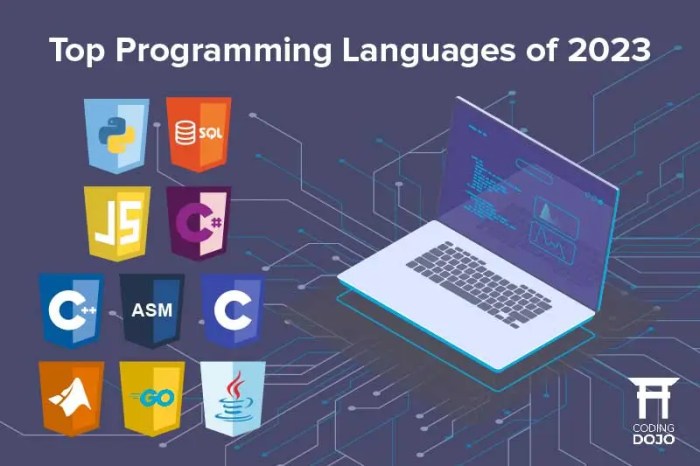7 most in demand programming languages * – 7 Most In-Demand Programming Languages: In the ever-evolving landscape of technology, staying ahead of the curve is crucial. Programming languages are the building blocks of software, and understanding which ones are most sought after can be a game-changer for aspiring developers and seasoned professionals alike.
This guide dives into the top 7 most in-demand programming languages, exploring their strengths, weaknesses, and the exciting opportunities they offer.
The popularity of a programming language is influenced by various factors, including its versatility, community support, ease of learning, and the demand from industries. Understanding these factors can help you make informed decisions about which languages to prioritize in your learning journey.
The Ever-Changing World of Programming Languages
The world of programming languages is constantly evolving. New languages emerge, existing languages gain new features, and the popularity of languages fluctuates based on various factors. Keeping up with these changes is crucial for programmers who want to stay relevant and competitive in the job market.
Factors Influencing Language Popularity
The popularity of a programming language is influenced by several factors, including:
- Ease of Learning:Languages that are relatively easy to learn and use attract a larger developer community. Python, for example, is known for its clear syntax and beginner-friendly nature.
- Community Support:A strong and active community provides ample resources, libraries, and support for developers. This is a significant factor in the popularity of languages like JavaScript and Java.
- Industry Demand:Languages in high demand within specific industries naturally gain popularity. For example, C++ remains popular in areas like game development and high-performance computing.
- Performance and Efficiency:Languages that offer excellent performance and efficiency are favored for tasks demanding speed and resource optimization. C++ and Rust are often chosen for these purposes.
- Versatility and Use Cases:Languages that can be applied to a wide range of tasks and domains tend to be more popular. Python’s versatility in data science, web development, and scripting has contributed to its widespread adoption.
Top 7 In-Demand Programming Languages
The world of programming is constantly evolving, with new languages emerging and existing ones gaining or losing popularity. Staying ahead of the curve and understanding the most in-demand languages is crucial for aspiring and seasoned developers alike. These languages are not only sought after by employers but also reflect the trends and needs of the technology industry.
The Top 7 In-Demand Programming Languages
The following table Artikels the top 7 in-demand programming languages as of today, based on various metrics including popularity, job market demand, and community support.
| Language Name | Popularity Rank | Key Applications | Advantages | Disadvantages |
|---|---|---|---|---|
| Python | 1 | Web development, data science, machine learning, artificial intelligence, scripting | Easy to learn, versatile, large community, extensive libraries | Can be slower than compiled languages, not the best choice for performance-critical applications |
| JavaScript | 2 | Web development (front-end and back-end), mobile app development, game development | Widely used, runs in web browsers, large community, versatile | Can be challenging to debug, asynchronous programming can be complex |
| Java | 3 | Enterprise applications, Android app development, big data | Mature language, platform-independent, strong security features, large community | Can be verbose, not as beginner-friendly as Python, requires more setup and configuration |
| C# | 4 | Windows applications, game development (Unity), web development | Fast and efficient, object-oriented, strong library support, integrated with Microsoft technologies | Limited platform independence, requires Microsoft development environment |
| C++ | 5 | High-performance applications, game development, operating systems, embedded systems | Fast and efficient, low-level control, widely used, mature language | Complex syntax, steeper learning curve, memory management can be challenging |
| PHP | 6 | Web development (server-side), content management systems (WordPress), e-commerce | Easy to learn, large community, widely used, good for dynamic websites | Can be insecure if not used properly, not as robust as other languages |
| Swift | 7 | iOS and macOS app development, server-side development | Fast and modern, safe and secure, easy to learn, Apple-supported | Limited platform independence, relatively new language, smaller community compared to others |
Python
Python’s popularity stems from its versatility, readability, and extensive ecosystem of libraries. Its simple syntax makes it accessible to beginners, while its powerful capabilities attract experienced developers. This combination of accessibility and power makes Python a valuable asset in diverse fields.
Prominent Companies Using Python
Python’s widespread adoption is evident in the extensive list of companies leveraging its capabilities.
- Google:Python plays a crucial role in Google’s infrastructure, from search algorithms to internal tools.
- Facebook:Python powers many aspects of Facebook’s operations, including data analysis and infrastructure management.
- Netflix:Python is integral to Netflix’s recommendation engine and backend systems.
- Spotify:Python facilitates Spotify’s music recommendation system and data analysis tasks.
- Dropbox:Python is used extensively in Dropbox’s file synchronization and storage services.
Python’s Use Cases
Python’s adaptability extends to various domains, including:
Data Science and Machine Learning
Python’s data analysis libraries, such as Pandas, NumPy, and SciPy, make it a popular choice for data scientists and machine learning engineers. These libraries offer powerful tools for data manipulation, analysis, and visualization. Python’s machine learning libraries, like scikit-learn, TensorFlow, and PyTorch, provide a comprehensive framework for developing and deploying machine learning models.
Web Development
Python’s web frameworks, such as Django and Flask, simplify the process of building web applications. These frameworks offer features for routing, templating, and database interaction, allowing developers to focus on building the core functionality of their applications.
Automation
Python’s scripting capabilities make it ideal for automating tasks. Its libraries, such as Selenium and Beautiful Soup, enable web scraping and automation of repetitive actions. Python’s simplicity and versatility make it an effective tool for automating tasks across various domains.
JavaScript
JavaScript is a versatile and dynamic programming language that has become an indispensable tool for web developers. Its ubiquity in web development, combined with its growing presence in mobile app development and server-side programming, makes JavaScript a highly sought-after skill for programmers.
JavaScript’s Dominance in Web Development
JavaScript’s dominance in web development stems from its ability to add interactivity and dynamic behavior to web pages. It allows developers to create engaging user experiences, including:
- Responding to user interactions, such as mouse clicks, keyboard input, and form submissions.
- Manipulating the content and style of web pages, dynamically updating elements and creating visually appealing effects.
- Making web pages more responsive and engaging by providing real-time feedback to users.
- Creating interactive features like slideshows, animations, and games.
JavaScript Frameworks
JavaScript frameworks provide developers with pre-built components and libraries that simplify the development process and promote code reusability. Some of the most popular JavaScript frameworks include:
- React:Developed by Facebook, React is a popular library for building user interfaces. It uses a component-based approach to create reusable UI elements, making it efficient for developing complex applications.
- Angular:Developed by Google, Angular is a comprehensive framework that provides a complete solution for building web applications. It uses a component-based architecture and offers features like data binding, routing, and dependency injection.
- Vue.js:Vue.js is a progressive framework that can be used to build both single-page applications and complex web applications. It is known for its ease of learning and its ability to scale with the complexity of projects.
JavaScript’s Increasing Use in Mobile App Development and Server-Side Programming
JavaScript’s reach extends beyond web development. Its use in mobile app development and server-side programming is rapidly growing.
- Mobile App Development:Frameworks like React Native and Ionic allow developers to build cross-platform mobile applications using JavaScript. These frameworks leverage the power of JavaScript to create native-like experiences for both Android and iOS platforms.
- Server-Side Programming:Node.js is a JavaScript runtime environment that allows developers to build server-side applications using JavaScript. It is known for its scalability, speed, and event-driven architecture, making it suitable for building real-time applications and web servers.
Java: 7 Most In Demand Programming Languages *

Java has been a dominant force in the world of programming for over two decades. Its reputation for reliability, scalability, and a vast ecosystem has made it a mainstay in enterprise software development. Even in a landscape dominated by newer languages, Java continues to be a cornerstone for building robust and complex applications.
Java’s Enduring Relevance in Enterprise Software Development
Java’s longevity is attributed to its robust features and its ability to adapt to evolving technological demands. It excels in building enterprise-grade applications that require high performance, security, and scalability. Here are some key reasons why Java remains a top choice for enterprise software development:
- Platform Independence:Java’s “write once, run anywhere” principle allows developers to write code once and deploy it on any platform with a Java Virtual Machine (JVM). This portability significantly reduces development time and costs.
- Strong Security Features:Java’s built-in security features, such as sandboxing and access control, protect applications from malicious attacks and data breaches.
- Mature Ecosystem:Java boasts a rich ecosystem of libraries, frameworks, and tools that simplify development tasks. From Spring Boot for building microservices to Hibernate for object-relational mapping, developers have access to a wide range of resources to accelerate their projects.
- Large Community Support:Java has a vast and active community of developers, which provides ample resources for learning, troubleshooting, and collaboration.
Popular Java-Based Applications and Platforms
Java’s versatility has led to its widespread adoption in various industries. Here are some prominent examples of Java-based applications and platforms:
- Android Applications:Java is the primary language for developing Android applications, powering a vast majority of mobile apps used globally.
- Enterprise Resource Planning (ERP) Systems:Many leading ERP systems, such as SAP and Oracle, are built on Java, enabling businesses to manage their core operations efficiently.
- Financial Trading Systems:Java’s performance and reliability make it a preferred choice for building high-frequency trading systems, where speed and accuracy are paramount.
- Big Data and Analytics Platforms:Java is used extensively in big data technologies like Hadoop and Spark, enabling organizations to process and analyze massive datasets.
- Web Applications:Java is widely used for developing web applications, leveraging frameworks like Spring MVC and Jakarta EE.
Benefits of Java’s Platform Independence and Robust Ecosystem
Java’s platform independence and robust ecosystem offer significant advantages for developers and businesses:
- Reduced Development Costs:By writing code once and deploying it across different platforms, Java minimizes development time and resources.
- Enhanced Scalability:Java’s architecture and performance make it suitable for building scalable applications that can handle large user bases and complex workloads.
- Improved Security:Java’s built-in security features ensure that applications are protected from vulnerabilities and malicious attacks.
- Faster Development Cycles:The availability of a wide range of libraries and frameworks in the Java ecosystem speeds up development processes and reduces the time to market.
C#

C# is a versatile and powerful programming language that has gained immense popularity in various domains, particularly in Windows development and game development. Its robust features, strong performance, and extensive libraries make it a top choice for building complex and scalable applications.
C# and Windows Development
C# is deeply intertwined with the Microsoft .NET framework, a comprehensive platform that provides a wide range of tools and libraries for developing applications across various platforms. The synergy between C# and .NET has solidified C#’s position as the primary language for Windows development.
- Windows Applications:C# is widely used for building traditional Windows desktop applications, leveraging the .NET framework’s rich libraries for user interface design, data access, and other functionalities.
- Web Applications:With the advent of ASP.NET, C# has become a leading language for building web applications, utilizing its powerful features for handling web requests, managing databases, and creating dynamic web pages.
- Windows Services:C# is also used for developing Windows services, which run in the background and perform tasks such as data processing, monitoring, and scheduling.
C# and Game Development
C# has gained significant traction in the gaming industry, particularly with the rise of Unity, a popular game engine that heavily relies on C#.
- Unity Game Engine:Unity’s scripting language is based on C#, providing developers with a familiar and powerful tool for creating games across multiple platforms, including PC, mobile, and consoles.
- Cross-Platform Development:C# with Unity allows developers to create games that can be deployed on various platforms without significant code changes, maximizing reach and reducing development time.
- Performance and Efficiency:C#’s strong performance and ability to handle complex game logic make it a suitable language for developing high-quality, immersive gaming experiences.
The .NET Framework
The .NET framework plays a pivotal role in C# development, providing a foundation for building applications that run on Windows and other platforms.
- Common Language Runtime (CLR):The CLR is a virtual machine that manages the execution of C# code, providing memory management, garbage collection, and other runtime services.
- Base Class Library (BCL):The BCL provides a vast collection of classes and interfaces that offer functionalities for various tasks, such as file I/O, networking, and data manipulation.
- ASP.NET:ASP.NET is a framework for building web applications using C#, providing features for handling web requests, generating HTML, and working with databases.
- Windows Forms:Windows Forms is a library for creating traditional Windows desktop applications using C#, providing tools for building user interfaces, handling events, and interacting with the operating system.
- WPF (Windows Presentation Foundation):WPF is a library for creating modern, visually rich Windows applications using C#, offering advanced features for graphics, animation, and user interface design.
C#’s Performance and Scalability
C# is known for its strong performance and ability to handle large-scale projects. Its compiled nature and the efficient runtime environment provided by the .NET framework contribute to its speed and efficiency.
- Compiled Language:C# code is compiled into machine code, which allows for faster execution compared to interpreted languages.
- Garbage Collection:The CLR’s garbage collection mechanism automatically manages memory allocation and deallocation, reducing the risk of memory leaks and improving performance.
- Asynchronous Programming:C# supports asynchronous programming, enabling developers to handle long-running operations without blocking the main thread, improving responsiveness and performance.
- Scalability:C#’s strong performance and the .NET framework’s robust infrastructure make it suitable for building large-scale applications that can handle high volumes of data and users.
C++
C++ is a powerful and versatile programming language that has been around for decades. It’s known for its performance and efficiency, making it a popular choice for various applications, from operating systems to game development.
Performance and Power
C++ is renowned for its performance and efficiency. It allows developers to have fine-grained control over system resources, making it suitable for tasks demanding optimal performance. This is achieved through features like:* Low-level memory management:C++ provides direct memory access, allowing developers to optimize memory usage and minimize overhead.
Direct hardware interaction
C++ allows developers to interact with hardware directly, enabling efficient resource utilization.
Performance-oriented libraries
C++ offers a rich set of libraries optimized for performance, including the Standard Template Library (STL), which provides efficient data structures and algorithms.
Applications of C++
C++’s versatility has led to its use in a wide range of applications, including:* System Programming:C++ is commonly used for developing operating systems, device drivers, and embedded systems. For example, Windows, macOS, and Linux operating systems are built using C++.
Game Development
C++ is a popular choice for game development due to its performance and ability to interact with graphics hardware directly. Many popular game engines, like Unreal Engine and Unity, are written using C++.
High-Performance Computing
C++ is used in fields like scientific computing, financial modeling, and machine learning, where high performance is crucial.
Learning C++
Learning C++ can be challenging, especially for beginners. Its complex syntax and the need for manual memory management can pose a steep learning curve. However, C++’s power and performance make it a valuable skill for experienced developers.
Suitable for Experienced Developers
C++ is often recommended for developers with prior programming experience. Understanding fundamental programming concepts like data structures, algorithms, and memory management is crucial for effectively using C++. It is well-suited for experienced developers who are willing to invest the time and effort to master its complexities.
Swift
Swift is a relatively new programming language, first introduced by Apple in 2014. However, it has rapidly gained popularity, becoming the primary language for developing apps for Apple’s iOS and macOS platforms. This rise in popularity can be attributed to its modern design, focus on safety, and performance, making it an attractive option for developers seeking to build robust and user-friendly applications.
Swift’s Focus on Safety and Performance
Swift’s design emphasizes safety and performance. It features strong typing, which helps prevent errors by ensuring that data types are correctly handled. This feature reduces the likelihood of unexpected crashes and improves code stability. Additionally, Swift’s compiler is optimized for speed, resulting in efficient code execution and faster app performance.
“Swift is a safe, fast, and modern programming language for macOS, iOS, watchOS, tvOS, and Linux. It’s designed to be easy to learn and use, while still being powerful enough to build complex applications.”
Apple Developer Website
Swift’s Potential for Cross-Platform Development
While Swift is primarily known for its use in Apple’s ecosystem, its potential extends beyond iOS and macOS development. The language is open-source and has gained support for other platforms, including Linux. This cross-platform compatibility allows developers to leverage their Swift skills to build applications for a wider audience.
Obtain access to dutch are world leaders in lab grown meat but cant eat it meatable to private resources that are additional.
Swift’s Growing Community
Swift has a vibrant and growing community of developers. This community actively contributes to the language’s development, providing support, sharing resources, and fostering innovation. The availability of numerous libraries, frameworks, and tools further enhances Swift’s capabilities and simplifies development processes.
Go
Go, also known as Golang, has gained immense popularity in recent years, becoming a go-to choice for developers working on various projects. Its simplicity, efficiency, and focus on concurrency make it particularly well-suited for modern software development, especially in areas like cloud computing, web services, and DevOps.
Reasons for Go’s Popularity
Go’s popularity stems from its unique features and advantages:
- Simplicity:Go’s syntax is intentionally simple and straightforward, making it easy to learn and understand. This simplicity contributes to faster development cycles and reduces the likelihood of errors.
- Concurrency:Go’s built-in concurrency features, including goroutines and channels, allow developers to write efficient and scalable applications that can handle multiple tasks simultaneously. This is crucial for modern applications that need to handle a high volume of requests.
- Efficiency:Go is a compiled language, which means it is translated directly into machine code, resulting in fast execution speeds. It also has a garbage collector that automatically manages memory, freeing developers from manual memory management tasks.
Go’s Use Cases
Go’s features make it ideal for a wide range of applications, including:
- Cloud Computing:Go’s efficiency and concurrency make it a perfect choice for building scalable and reliable cloud-based services. Companies like Google, Dropbox, and Uber use Go extensively for their cloud infrastructure.
- Web Services:Go’s ability to handle concurrent requests efficiently makes it suitable for developing web services and APIs. Frameworks like Gin and Echo provide robust tools for building web applications.
- DevOps:Go’s simplicity and speed make it a preferred choice for building tools and automation scripts for DevOps tasks, such as system administration, infrastructure management, and continuous integration/continuous delivery (CI/CD).
Examples of Companies and Projects Using Go
Many prominent companies and projects have adopted Go for its advantages:
- Google:Go was originally developed at Google, and it is used extensively within the company for various services, including Google Search, YouTube, and Kubernetes.
- Docker:The popular containerization platform Docker is built using Go, leveraging its concurrency and efficiency to manage containers and orchestrate deployments.
- Netflix:Netflix uses Go for its internal tools and services, including its streaming platform and recommendation engine.
Future Trends
The programming landscape is constantly evolving, with new languages emerging and existing ones adapting to meet the demands of ever-changing technologies. Understanding these trends is crucial for developers who want to stay ahead of the curve and remain competitive in the job market.
Impact of Artificial Intelligence and Quantum Computing
Artificial intelligence (AI) and quantum computing are two disruptive technologies that are poised to significantly impact the programming landscape. AI is already driving the development of new programming languages specifically designed for machine learning and deep learning tasks. These languages, such as TensorFlow and PyTorch, provide specialized tools and libraries for building and training AI models.
Quantum computing, with its ability to solve complex problems that are intractable for classical computers, is expected to revolutionize programming. Quantum programming languages like Q# and Cirq are being developed to harness the power of quantum computers. These languages will likely require developers to learn new paradigms and concepts, such as superposition and entanglement, to effectively program these machines.
Future of Popular Languages
While new languages are emerging, existing popular languages are also evolving and adapting to meet the challenges of the future.
- Python, known for its simplicity and versatility, is expected to continue its dominance in areas like data science, machine learning, and web development. Its extensive libraries and active community will continue to drive its growth.
- JavaScript, the language of the web, will remain crucial for front-end development and is also gaining popularity for back-end development with frameworks like Node.js.
- Java, a robust and widely used language, will likely remain relevant for enterprise applications and mobile development. Its strong ecosystem and mature libraries will continue to support its longevity.
- C#, a versatile language used for various applications, is expected to maintain its popularity in areas like game development and enterprise applications. Its strong performance and integration with the .NET framework will continue to be valuable assets.
- C++, a powerful language known for its performance, will continue to be essential for systems programming, game development, and high-performance computing. Its low-level control and efficiency will remain highly sought after in these domains.
- Swift, a modern and safe language developed by Apple, is expected to gain further traction in iOS and macOS development. Its focus on safety and ease of use will likely make it an attractive choice for mobile developers.
- Go, a language designed for concurrency and scalability, is expected to see increased adoption in areas like cloud computing and distributed systems. Its efficiency and ease of use will likely make it a popular choice for these applications.
Potential Newcomers, 7 most in demand programming languages *
New languages are constantly emerging, and some have the potential to become significant players in the future.
- Rust, a language focused on safety and performance, has gained traction in systems programming and web development. Its emphasis on memory safety and concurrency could make it a compelling choice for future applications.
- Kotlin, a language designed for Android development, is gaining popularity due to its concise syntax and interoperability with Java. Its growing ecosystem and support from Google could lead to its wider adoption.
- TypeScript, a superset of JavaScript that adds static typing, is gaining popularity for large-scale web applications. Its ability to improve code quality and maintainability could make it a dominant language for front-end development.
Learning Resources
The journey to mastering any programming language starts with the right resources. There are countless options available, each with its own strengths and weaknesses. Choosing the right learning path depends on your individual goals, experience level, and learning style.
Online Courses
Online courses offer structured learning paths with interactive exercises, quizzes, and projects. They provide a comprehensive approach to learning a programming language, covering fundamental concepts and advanced topics.
- Codecademy: Offers interactive courses for beginners and experienced programmers. It provides a hands-on approach to learning with real-world examples and projects.
- Udemy: A platform with a vast library of programming courses taught by industry experts. You can find courses on all popular languages, covering various levels and specializations.
- Coursera: Offers courses from top universities and institutions, providing a more academic approach to learning. They cover a wide range of programming languages and related fields.
- edX: Similar to Coursera, edX provides online courses from renowned universities and institutions. They offer a blend of theory and practical applications, covering a diverse range of programming languages.
Tutorials and Documentation
Tutorials and official documentation are valuable resources for learning specific programming languages. They provide in-depth explanations of concepts, syntax, libraries, and frameworks.
- W3Schools: A comprehensive website with tutorials and references for various programming languages, including HTML, CSS, JavaScript, and Python. It offers interactive exercises and examples to solidify your understanding.
- Mozilla Developer Network (MDN): A resource for web technologies, including JavaScript, HTML, and CSS. It provides detailed documentation, tutorials, and examples for developers of all levels.
- Official Language Documentation: Every programming language has official documentation, which is the most authoritative source for learning its syntax, libraries, and features. These documents are usually maintained by the language’s developers and are constantly updated.
Communities and Forums
Connecting with other programmers is essential for learning and growth. Online communities and forums provide a platform to ask questions, share knowledge, and get help from experienced developers.
- Stack Overflow: A question-and-answer website for programmers. It is a vast repository of programming knowledge, where you can find answers to your questions and contribute to the community by answering others.
- Reddit: Numerous subreddits dedicated to specific programming languages and topics. They offer a platform for discussions, sharing resources, and seeking help from fellow programmers.
- GitHub: A platform for hosting and collaborating on software projects. It is a valuable resource for learning from open-source projects, contributing to the community, and connecting with other developers.
Choosing the Right Learning Path
The best learning path depends on your individual needs and goals. Consider these factors:
- Experience Level: Beginners might benefit from structured courses, while experienced programmers might prefer tutorials and documentation.
- Learning Style: Some prefer visual learning through videos, while others prefer hands-on exercises.
- Goals: Define your objectives, whether it’s to build websites, develop mobile apps, or work on data science projects.





